| 12 π basshorn - Coming together - Part 1 [message #47431] |
Thu, 04 August 2005 00:19  |
 |
 Wayne Parham
Wayne Parham
Messages: 18984
Registered: January 2001
|
Illuminati (33rd Degree) |
|
|
With the help of Bill Wassilak, the first 12π basshorn is about halfway done. I took a few photos to document the process, which will help make building them easier in the future.
First things first, I printed plans both at 1/6th scale (8.5x11 A4 paper) and 1/2 scale (A1 paper, 23x33). We then laid out the profile on a side panel by drawing it in pencil. This helps to maintain perspective and to keep track of where things go.
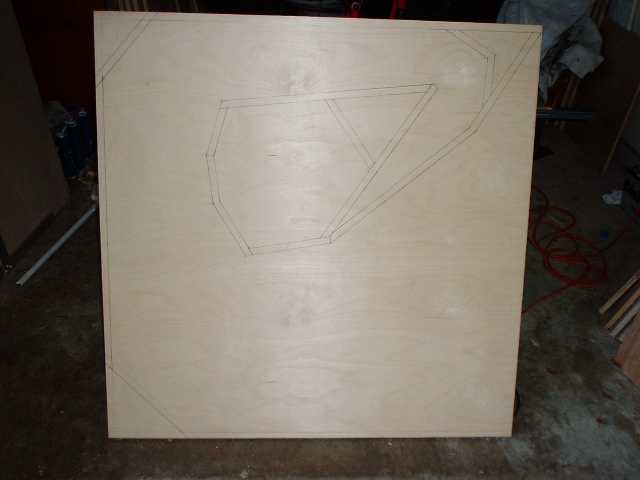 Flare profile drawn on side piece
Flare profile drawn on side piece
After cutting the side panels and drawing a profile on them, we proceeded to cut the rest of the panels. You can see the cut angles used above. It's more complicated to cut than a bass-reflex box or a π cornerhorn, but it's pretty straightforward with a table saw.
After cutting out all the sections that make up the flare, the next thing we did ws to cut the baffles for the motor chamber. Two need holes for the woofers, one does not.
 Motor chamber baffles resting on bottom piece.
Motor chamber baffles resting on bottom piece.
Next we cut the throat piece and began to assemble the motor chamber.
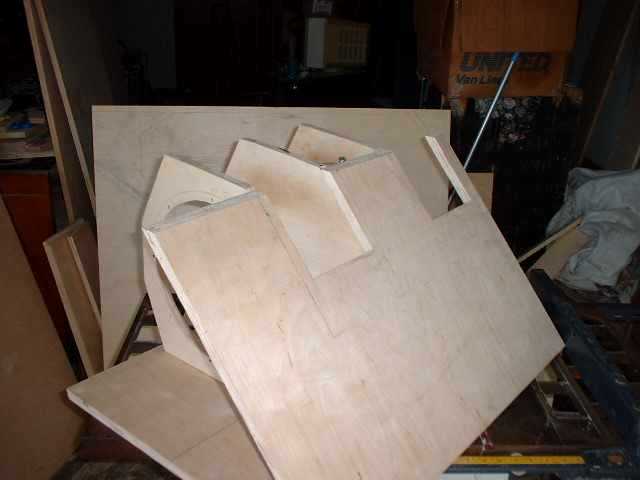 Throat piece on motor chamber
Throat piece on motor chamber
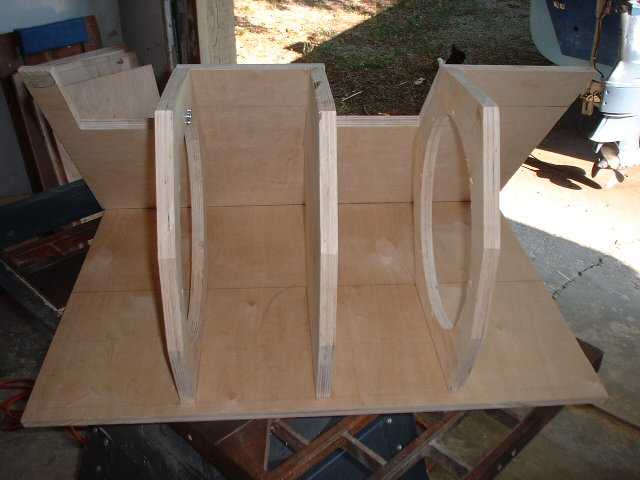 Throat piece on motor chamber, viewed from behind
Throat piece on motor chamber, viewed from behind
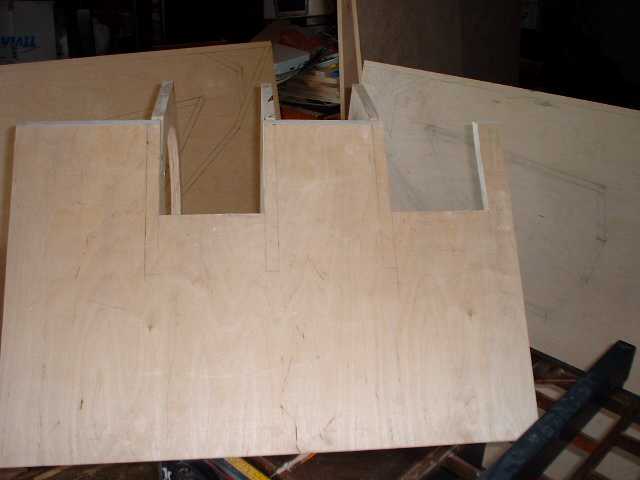 Throat piece on motor chamber, looking at throat holes
Throat piece on motor chamber, looking at throat holes
Seven panels surround the motor chamber, so now we trim and fit each one. We started with the the front piece and worked our way around the the back pieces.
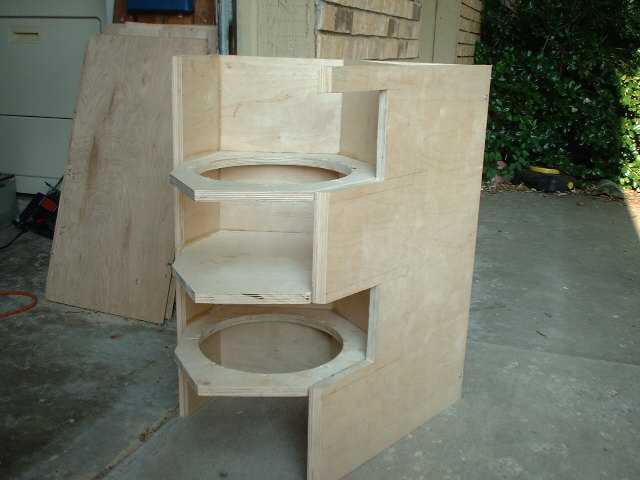 Motor chamber front piece and one of the rear pieces installed
Motor chamber front piece and one of the rear pieces installed
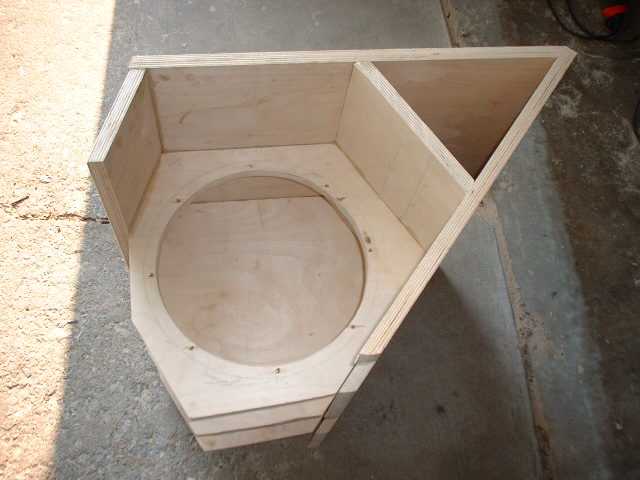 Motor chamber side view, showing baffles
Motor chamber side view, showing baffles
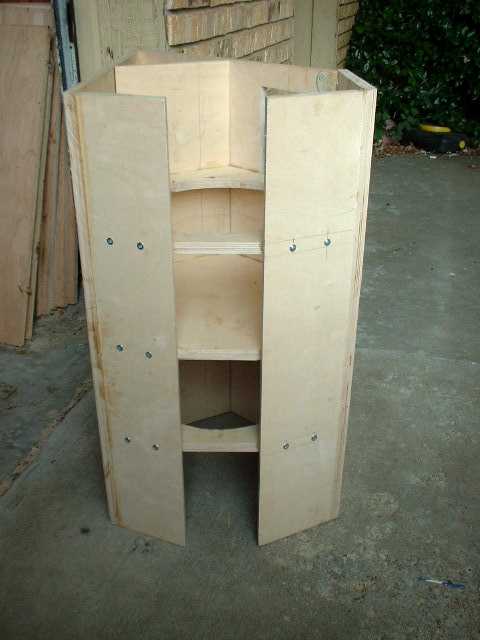 Motor chamber, almost finished
Motor chamber, almost finished
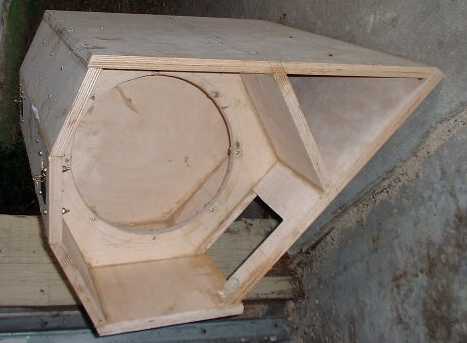 Completed motor chamber, side view
Completed motor chamber, side view
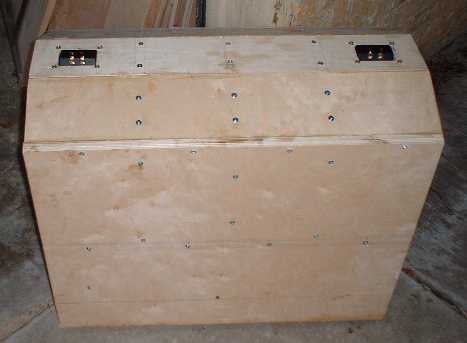 Motor chamber, top view - Notice connectors on rear panel
Motor chamber, top view - Notice connectors on rear panel
Next step is to add fill to the front chambers to displace some of the volume and reduce the size of the front chamber. Cut pieces and glue them in, using clamps where necessary.
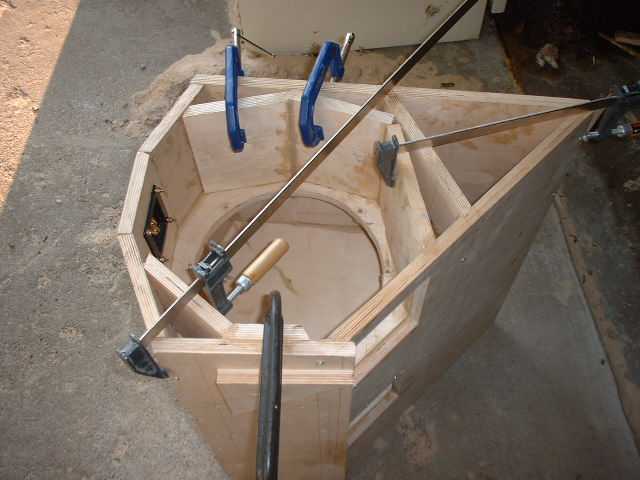 Inserting fill pieces to reduce front chamber volume
Inserting fill pieces to reduce front chamber volume
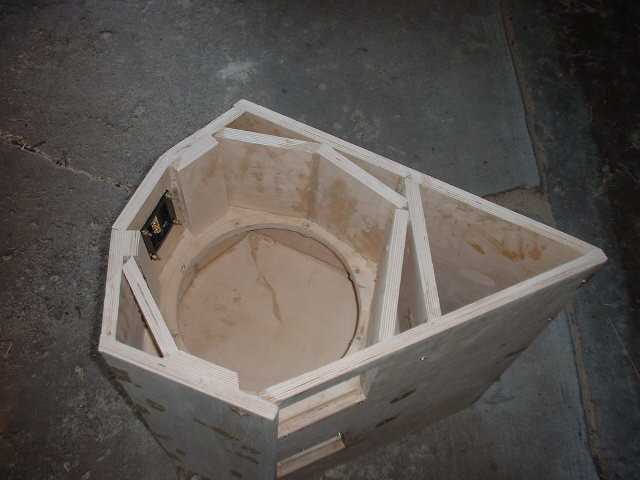 Outer chamber fill
Outer chamber fill
Two pieces are installed on the outer front chamber that are not installed on the inner front chamber. This is due to the difference in widths of the front chambers, and it keeps the volume of each exactly the same. Notice the two pieces near the speaker connector terminal on the outer chamber are not present on the inner chamber.
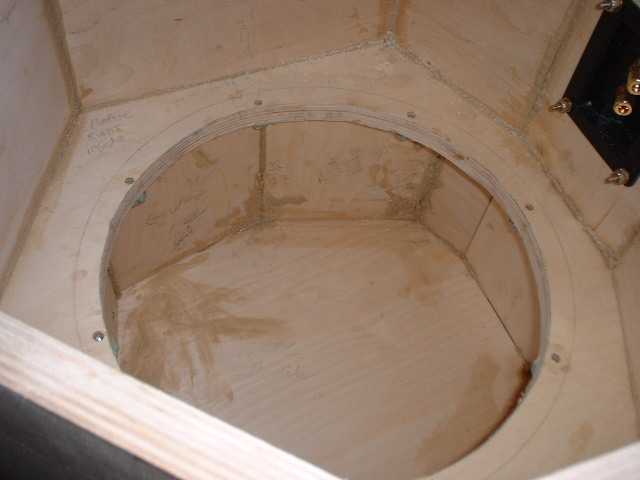 Inner chamber fill, viewed from top
Inner chamber fill, viewed from top
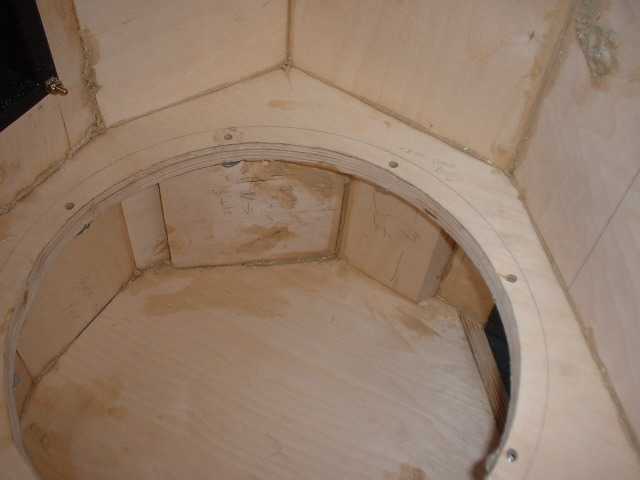 Inner chamber fill, viewed from bottom
Inner chamber fill, viewed from bottom
Now route the side panels so the access panel / heat exchanger can be installed flush. The panel is 1/4" thick, and a gasket is installed so route the edge 9/16" deep for a flush fit.
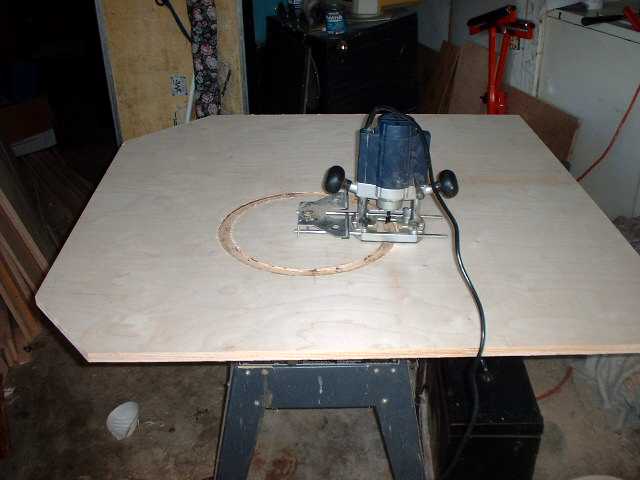 Routing access panel hole
Routing access panel hole
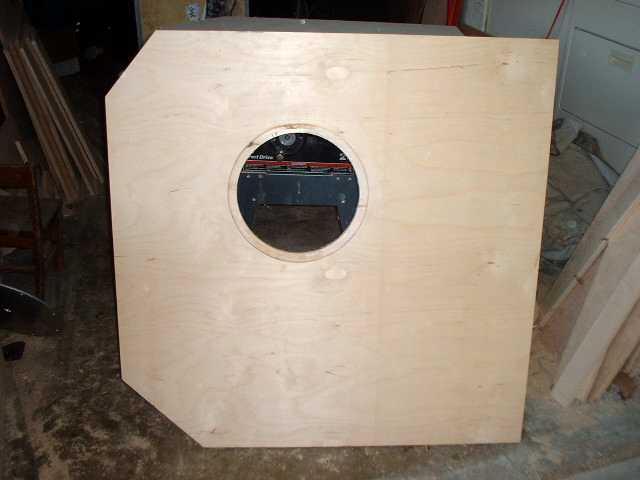 Side panels with access panel hole routed
Side panels with access panel hole routed
After the side panels have access holes, install T-Nuts in each side. Apply a dab of epoxy on each and tighten them in place.
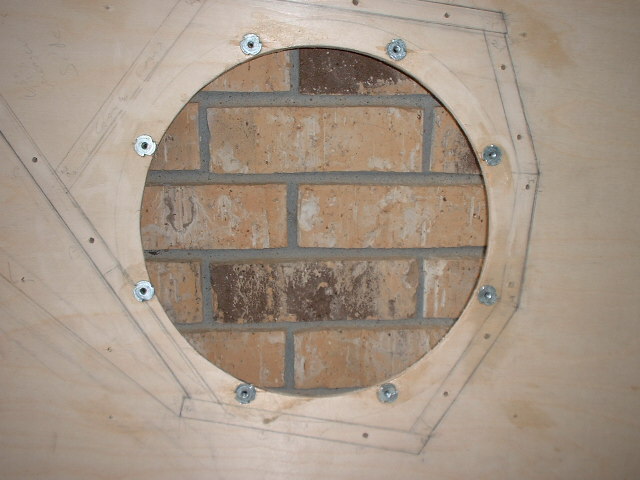 T-Nuts for side covers installed
T-Nuts for side covers installed
Notice that some of the T-Nuts interfere with the motor chamber or fill. Remove just enough material on the edge of the motor chamber that the T-Nuts do not standoff the sides from the motor chamber. They're about 1/16" thick when fully inserted, so you don't need to take off much. Also, drill holes in the motor chamber and fill so that screws used to attach the access panel / heat exchanger will not stop into the wood. After you have thoroughly checked that the side panel will fit flush and access panel screws can be inserted later, apply glue to the side panel and attach the motor chamber. Be sure to test fit the woofer, cooling plug and access plate and ensure proper alignment.
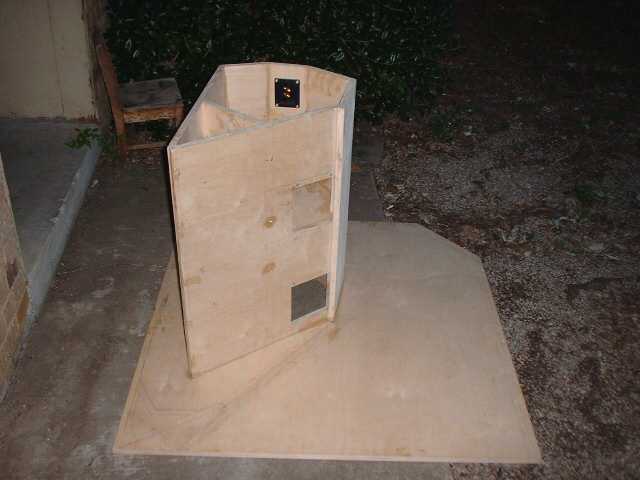 Attaching motor chamber to side panel
Attaching motor chamber to side panel
If you use screws to pull the motor chamber to the side panel, be sure to drill starter holes in both the side panel and motor chamber. The screws should pass through the side panels, and the holes in the motor chamber should be just large enough that the wood screws bite. The concern here is that you definitely do not want the screws to split the wood, so starter holes are important. When used right, screws won't split the wood but will act as permanent clamps that pull the pieces together tightly while the glue sets.
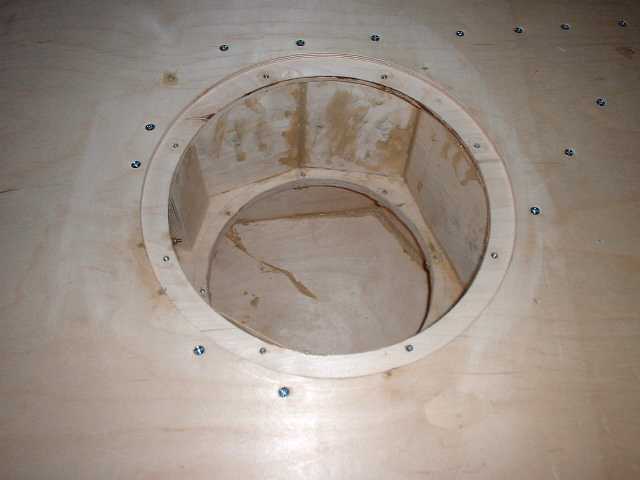 View into the motor chamber from side panel
View into the motor chamber from side panel |
|
|
|
|
|
|
|
|
|
|
|
|
|
|
|
| Re: 12 π basshorn - Coming together - Part 2 [message #47740 is a reply to message #47431] |
Sun, 18 September 2005 11:31   |
 |
 Wayne Parham
Wayne Parham
Messages: 18984
Registered: January 2001
|
Illuminati (33rd Degree) |
|
|
Now we build up the horn flare from the motor chamber outward. First, glue the throat panel brace in place. You might want to drill shallow holes and use a short 1/2" dowel section as a positioning pin.
 Motor chamber and throat panel brace
Motor chamber and throat panel brace
Attach the throat panel and the upper braces.
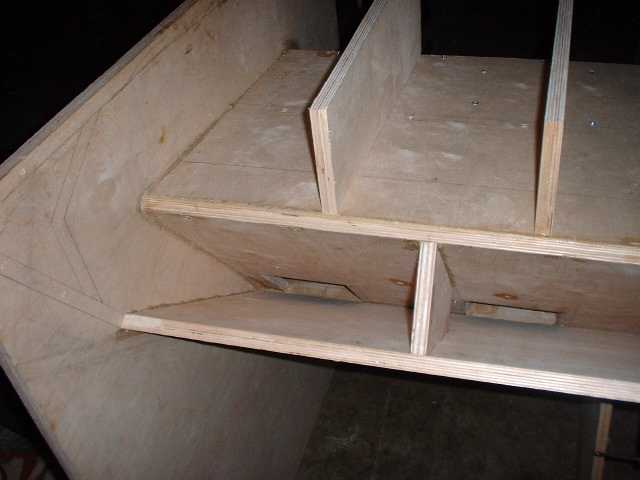 Throat expansion and braces
Throat expansion and braces
Attach the top and nose pieces. Both sides are attached to make sure fit is good. One side is glued and permanently attached, but the other side is only temporarily screwed in place.
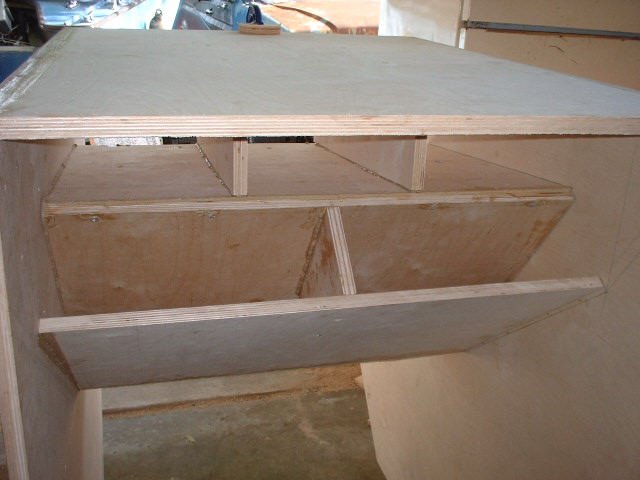 Throat panel and top
Throat panel and top
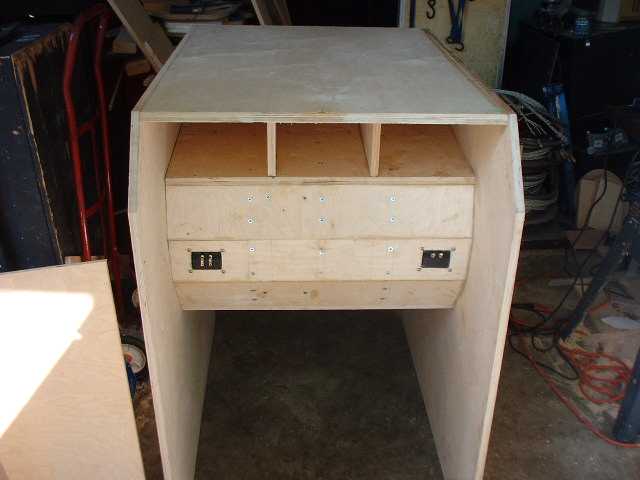 Rear view of motor chamber with sides and top attached
Rear view of motor chamber with sides and top attached
Prepare the back panel by cutting the connector panel hole and applying the finish coat. You won't want to paint after the panel is in place, so do it ahead of time. After it is dry, you can attach the back panel and connect the internal wiring. Notice the braces between motor chamber and back panel. Having the side mounted lets you check fit. This photo was taken after the back was already mounted and the side removed for easier access to horn internals.
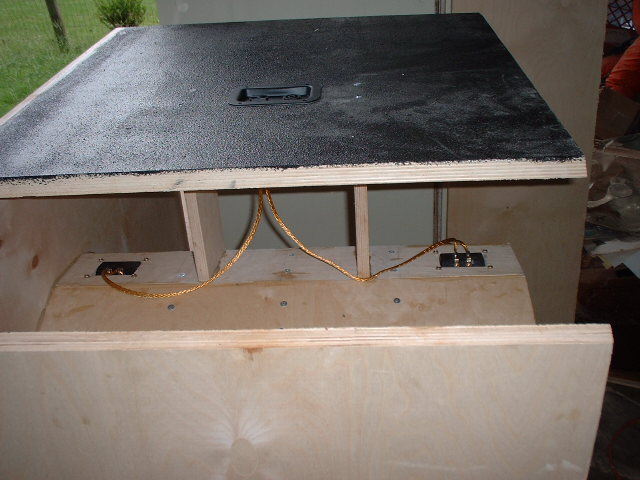 Internal wiring
Internal wiring
Similarly, the angled pieces in back must have their finish coat applied in advance. The top piece mounts a handle and the bottom piece mounts castor wheels. Notice the holes drilled for the castor wheels in the picture below.
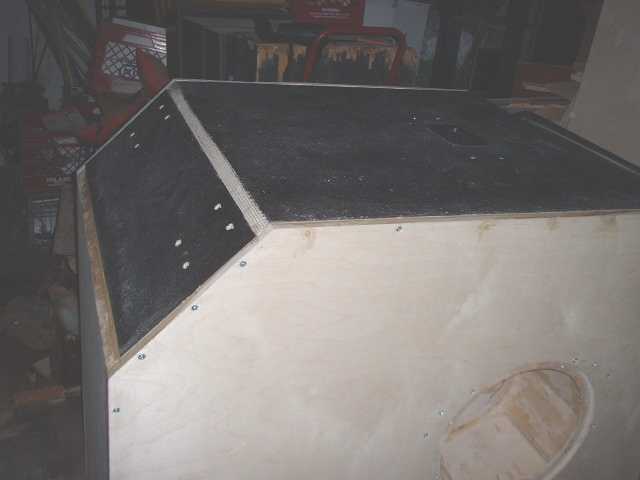 Back and Bottom
Back and Bottom
Cut holes and insert T-Nuts to mount the handle. Here we've test fit the handle before removing it again to provide the finish coat.
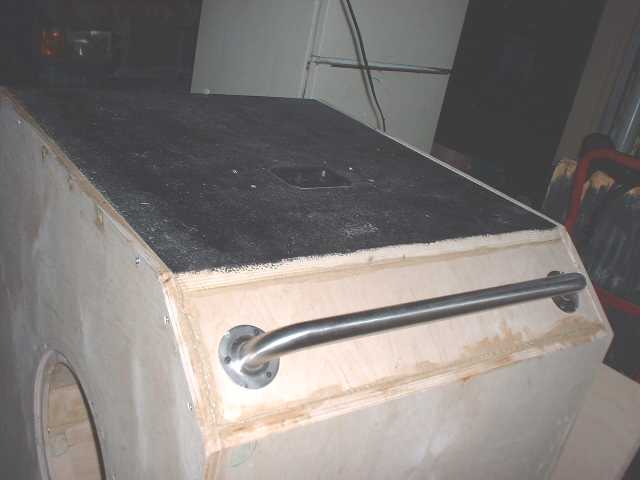 Back and top
Back and top
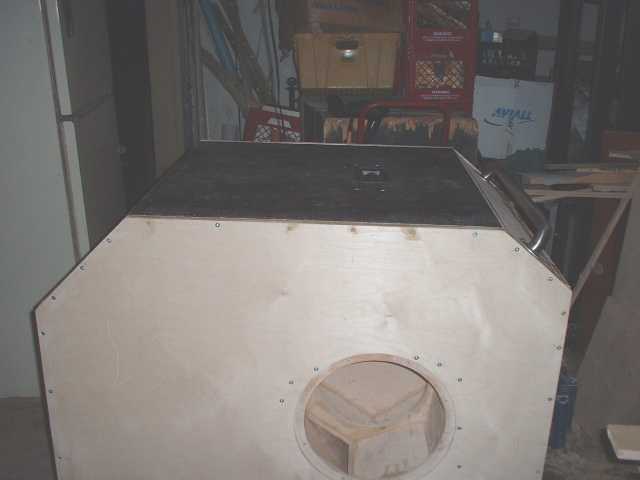 Back and side
Back and side
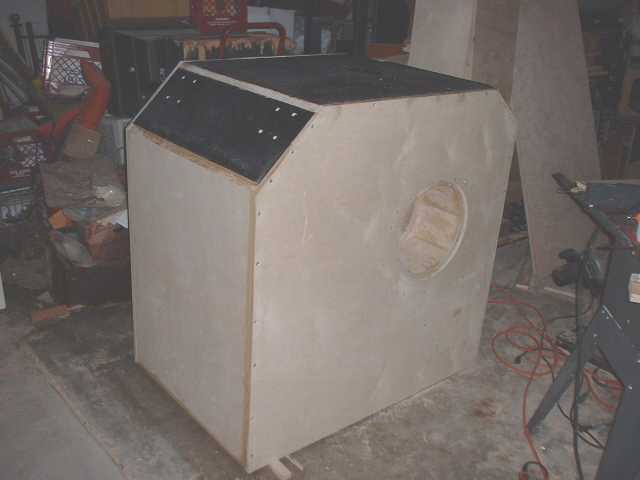 Face down
Face down
Attach braces for the diagonal pieces, both top and bottom. The bottom ones should be placed immediately above the castor wheels, to provide strength in this area. The braces on the top panel should be placed near the handle mounts to provide extra strength too. Mount the wheels and handle.
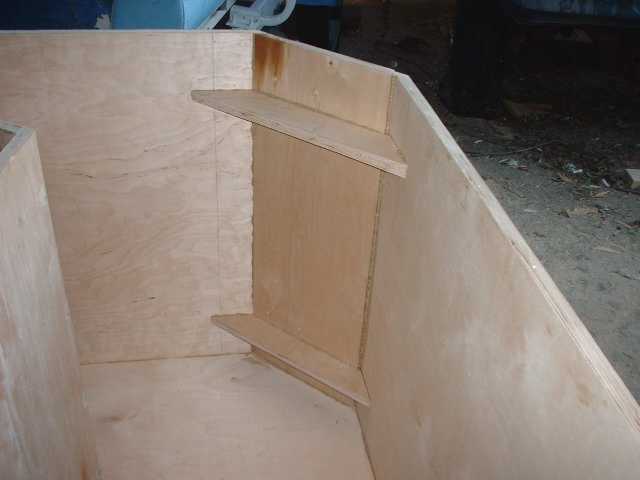 Bottom corner braces
Bottom corner braces
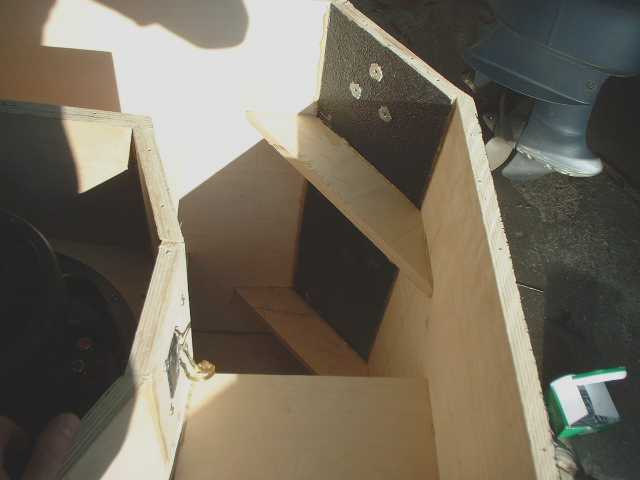 Top corner braces
Top corner braces
Add the braces for the mouth area, and then attach the side. Glue them in place and the horn is finished, ready for painting.
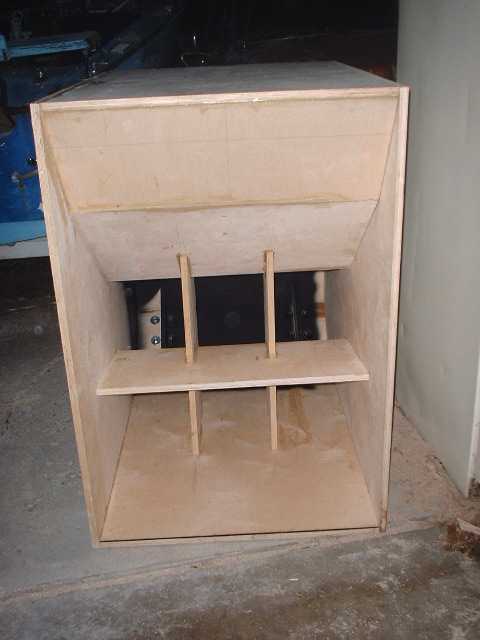 Front view, before paint
Front view, before paint
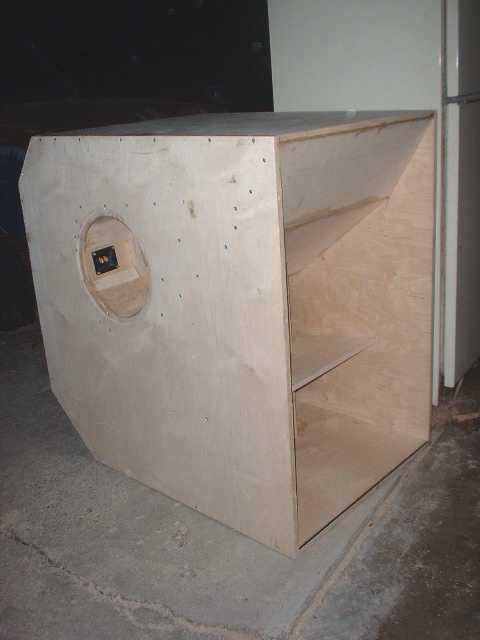 Side view, before paint
Side view, before paint |
|
|
|
| Re: 12 π basshorn - Coming together - Part 3 [message #47808 is a reply to message #47740] |
Mon, 26 September 2005 23:08  |
 |
 Wayne Parham
Wayne Parham
Messages: 18984
Registered: January 2001
|
Illuminati (33rd Degree) |
|
|
After the glue dries, paint the cabinet. Grab a gallon of truck bed liner and a course roller to provide the texture. The finish is easy to apply and very durable. Use an aerosol can to spray inner corners and other areas where the roller won't reach, then use the roller to cover the rest.
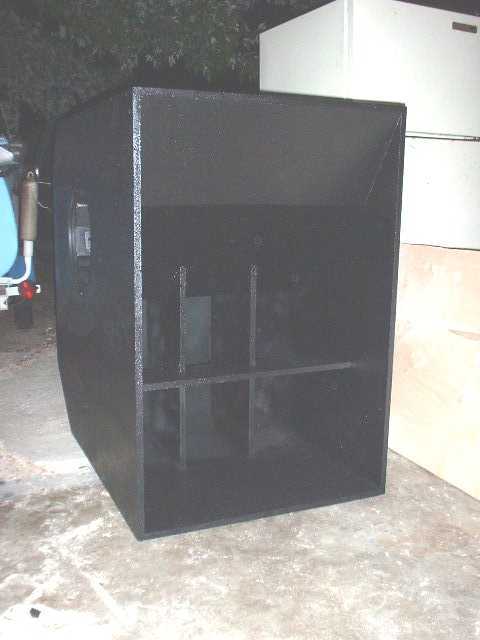 Finish applied
Finish applied
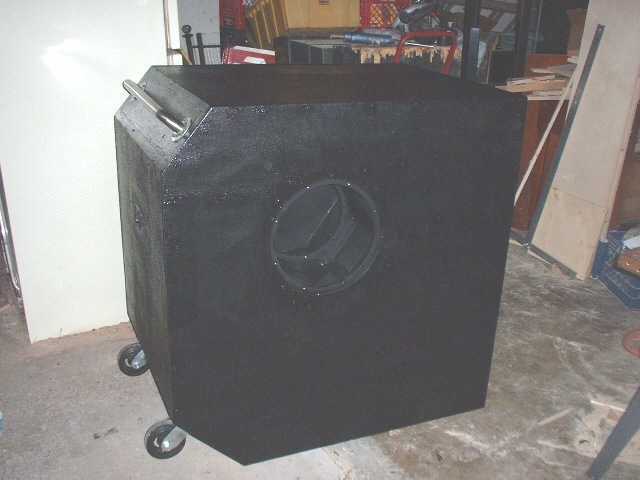 Side view of finished cabinet
Side view of finished cabinet
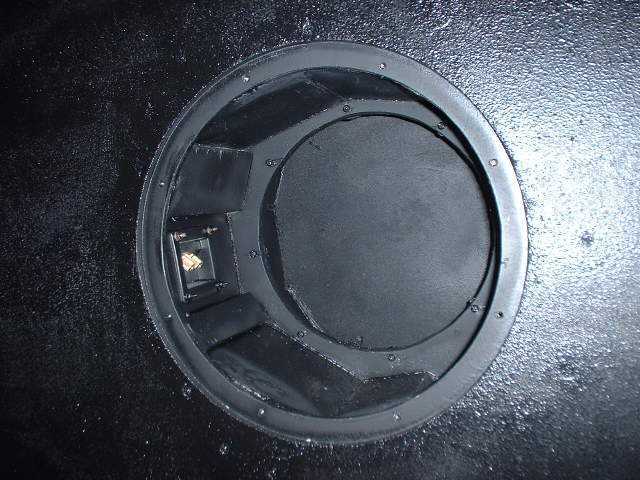 Ready for the drivers and heat exchanger
Ready for the drivers and heat exchanger
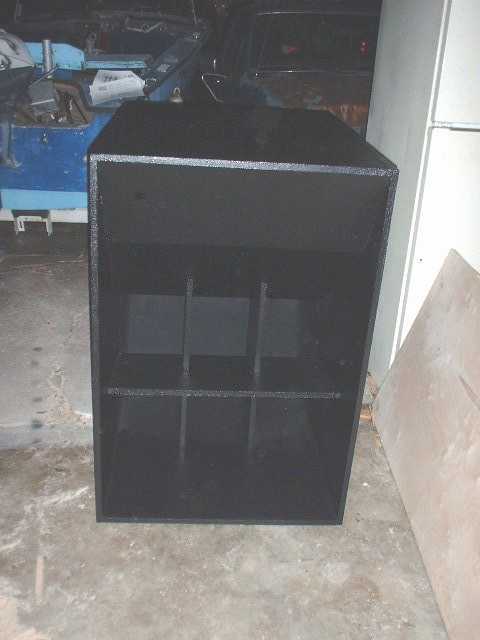 Front View
Front View
Use sheets of rubber or plastic for gasket material. The plastic used for making shower pans works well. Use the heat exchanger / access panel as a template and draw out a pattern, then cut it out with scissors and a hole punch.
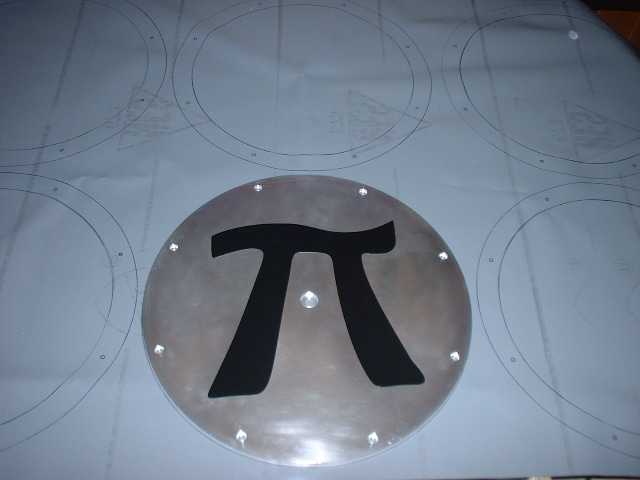 Drawing gasket outline, using access panel as a template
Drawing gasket outline, using access panel as a template
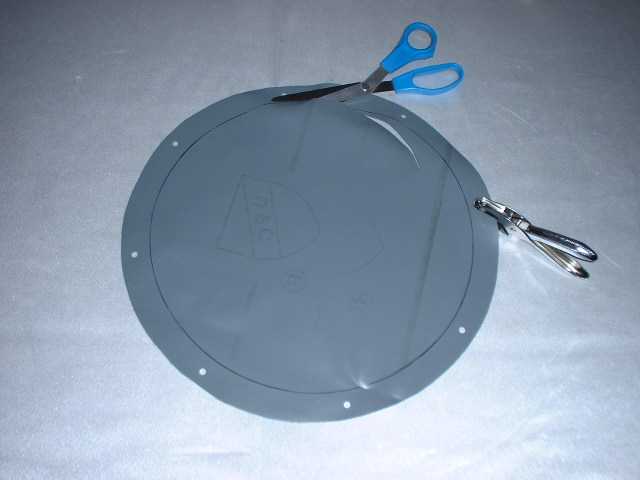 Cut gasket with scissors and a hole punch
Cut gasket with scissors and a hole punch
Before instaling the woofers, remove the protective mesh from the cooling vents. It is just pressed in, and comes out very easily. A small screwdriver can be used to pry it out. Lightly sand the paint from the vent with very fine 400 or 600 grit sandpaper. You may have to remove a few burrs in the metal on some woofers. Then clean the area with a paper towel and apply heat conductive grease.
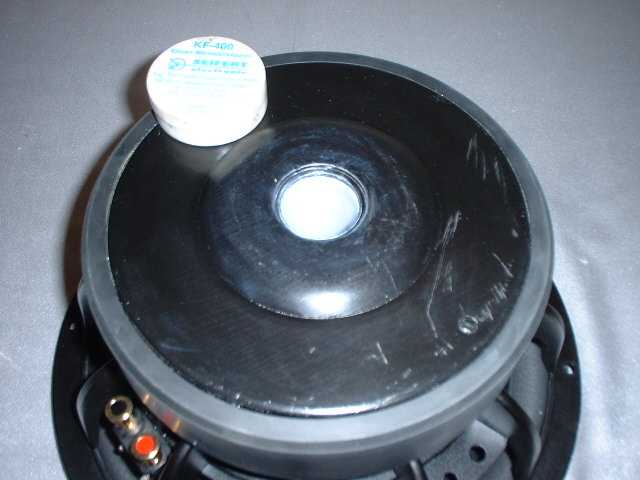 Heat conductive grease in woofer vent
Heat conductive grease in woofer vent
Install the woofers and connect them to the internal connector panels. It's a good idea to check the polarity of each woofer from the rear panel using a 9 volt battery. With the battery "+" connected to the input connector "+", both woofers should move towards the front chamber and throat. That means one will move outward and the other will move inward.
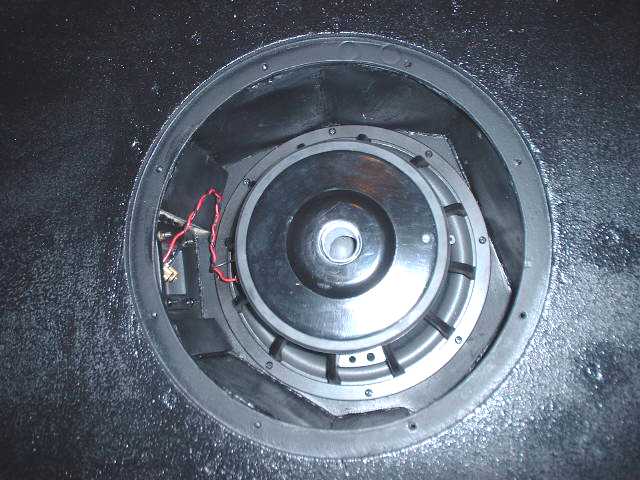 Woofers installed
Woofers installed
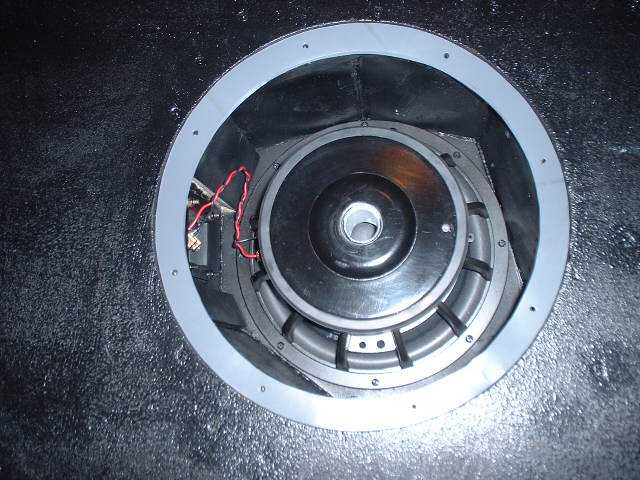 Gaskets in place
Gaskets in place
Install the heat exchanger / access panels and you're done!
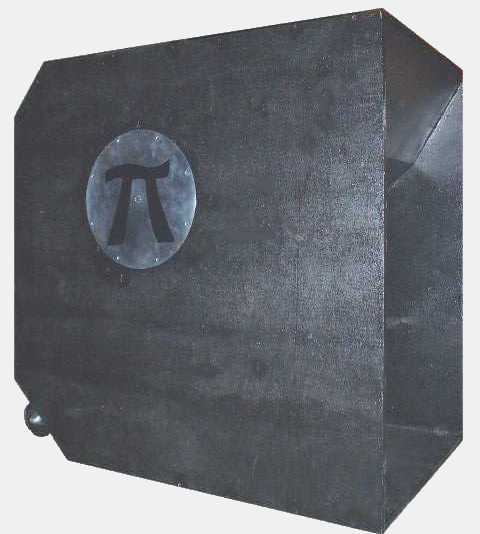 12π basshorn subwoofer, side view
12π basshorn subwoofer, side view
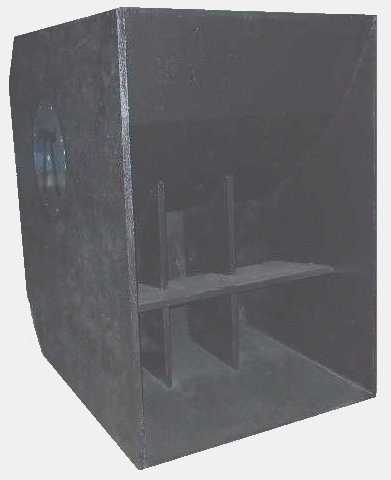 12π basshorn subwoofer, front view
12π basshorn subwoofer, front view |
|
|
|







